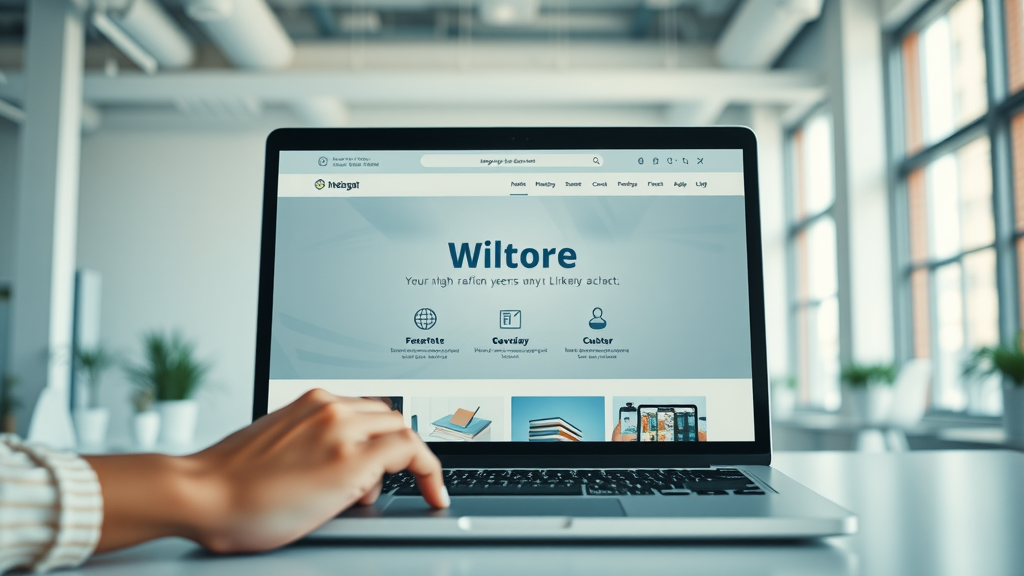Did you know that over 70% of purchasing decisions today are shaped by a business online presence? In an era where potential customers search, compare, and engage with brands online before ever making contact, your visibility on digital platforms can make or break your business success. This guide will show business owners and small businesses how to rapidly boost their online presence—attracting new customers, building trust, and staying ahead of the competition.
Did You Know? Over 70% of Purchasing Decisions Are Influenced by a Business Online Presence
In today’s digital-first world, a business online presence isn’t just important—it’s essential. Whether you operate a brick-and-mortar shop or an ecommerce brand, your online reputation and digital visibility heavily influence how both local and global audiences discover and trust your products and services . Many business owners underestimate the immense impact that a strong online presence can have on attracting potential customers, converting leads, and driving consistent growth.
Take, for example, a local business that’s optimized its website, strengthened its social media presence, and actively manages reviews. It will naturally appear higher in search results and gain more customer engagement than its competitors. This digital advantage is supported by studies showing over 70% of buyers consider a company’s website, reviews, and social media profiles before making purchasing decisions, underscoring the pressing need for all small businesses to take online presence seriously.

How a Strong Online Presence Drives Business Growth
A strong online presence opens the door to new opportunities for increasing sales and building long-term customer relationships. Businesses that consistently show up in search results , engage with followers on social media platforms, and nurture reviews reap the benefits of both greater visibility and enhanced credibility. In fact, a robust digital footprint not only brings in potential customers but also helps retain existing ones through active engagement and customer support across multiple channels.
Consider the ripple effect: When someone recommends your products or services online or leaves a positive review, your reach multiplies. Strong brand awareness online leads to improved conversion rates—especially important for small businesses seeking a competitive edge. For many business owners, prioritizing online presence is the first step toward sustainable, scalable growth.
"A strong online presence is no longer optional—it’s the backbone of market leadership for business owners and small businesses." – Digital Marketing Authority
Defining Business Online Presence and Its Critical Role
To achieve a truly impactful business online presence , it’s crucial to understand what it entails and why it matters so deeply for thriving in today’s marketplace. At its core, online presence means having consistent, up-to-date profiles and content across all digital platforms where your target audience spends time. This can include your professional website, social media profiles, directory listings, and actively managed customer reviews.
The scope of an online presence also speaks to your brand's visibility, reputation, and direct communication channels with both loyal customers and new prospects. From local search to social media engagement, every touchpoint online shapes perceptions and can influence buying decisions. Business owners who strategically manage these elements gain a significant edge, ensuring that their message reaches the right audience while building both trust and authority within their industry.
- Website
- Social media profiles
- Directory listings
- Online reviews
What is an online presence in business?
An online presence in business refers to all digital footprints that represent your brand, including your website, social media platforms, online business directories, and customer-generated content such as reviews. This collective presence acts as your business’s first impression to internet users—it’s how you are discovered, evaluated, and ultimately chosen over the competition. Maintaining a strong online presence means consistently aligning your digital assets with your brand values and ensuring accessibility for your target audience anytime, anywhere.

Why is it important for a business to have an online presence?
For modern business owners , having an online presence is an absolute necessity. Shoppers often research companies through search engines and social media before engaging, making these channels critical gateways for capturing attention and building credibility. Beyond simple visibility, an active and engaging online presence cultivates trust, enables direct communication, and can even develop lasting customer relationships. Without it, you risk losing prospective clients to competitors with a stronger digital footprint or even struggling to turn leads into sales.
A dynamic business online presence adds a layer of legitimacy that reassures both existing and new customers. It allows small businesses to compete on a more level playing field with larger brands while also providing valuable touchpoints for engaging with users, answering questions, and promoting products and services . Well-managed online profiles and content can transform a passive visitor into a loyal brand advocate—one positive interaction at a time.
How to increase online presence for business?
To increase your business online presence , start by ensuring you have a professional, easy-to-navigate website with clear calls to action. Next, actively claim and optimize your business profiles on key social media platforms where your target audience spends time. Focus on consistent branding across all digital channels—this includes your logo, messaging, and customer service tone. Search engine optimization (SEO) is another vital strategy; use industry-relevant keywords and ensure your site is mobile- and user-friendly to improve search result visibility.
Engage customers through email marketing, encourage online reviews, and keep your directory listings up-to-date for local SEO benefits. Regularly publish relevant, valuable content to your website and social channels to build authority and keep customers engaged. Finally, monitor your analytics and adapt your strategy based on what attracts and converts the most potential customers .
Do all businesses need to have an online presence?
In almost every industry and for all business owners , an online presence is no longer optional. Whether you operate primarily in a physical location or serve a nationwide audience, most potential customers will look for your business online before deciding to buy. While some small, hyper-local businesses might rely on word-of-mouth, having even a basic digital profile ensures you are discoverable when customers search.
With digital habits now ingrained in daily life, businesses lacking a media presence risk missing out on significant opportunities—and customers—who turn to search engines and social media platforms when seeking products or services . If you wish to grow, build trust, and remain relevant, building a strong online presence should be at the top of your to-do list.
Key Benefits of Cultivating a Strong Business Online Presence
Embracing a strategic approach to your business online presence comes with decisive advantages. Firstly, it enhances your visibility, allowing potential customers to discover your brand through search engines , directories, and social media . This exposure makes it far more likely that your products and services will be considered over competitors, especially among tech-savvy consumers.
Secondly, a robust online presence establishes and bolsters your credibility. Thoughtful content creation, positive customer reviews, and regular interaction demonstrate reliability and position your business as an authority. Strong engagement on digital channels fosters trust and encourages repeat business, while an expanding online footprint broadens your brand’s reach, connecting you to audiences you might never reach through traditional means.
- Enhanced visibility
- Increased credibility
- Better customer engagement
- Broader reach
Building a Strong Online Presence: Step-by-Step Guide
Creating a strong online presence is a step-by-step journey that any business owner can undertake with the right framework. Begin by launching a professional website that acts as the hub for your brand information, products or services , and contact details. Next, claim and polish social media profiles that align with your target audience’s preferences. These efforts must be complemented with robust search engine optimization —optimizing content, using relevant keywords, and ensuring mobile responsiveness for the best search result performance.
Once your foundational elements are set, implement email marketing campaigns that nurture customer relationships and drive repeat purchases. Don’t overlook the power of online reviews and reputation management : encouraging positive customer feedback and responding thoughtfully to both praise and criticism cements your authority while showcasing your commitment to customer satisfaction. By following these steps, business owners can transform their digital footprint and drive ongoing growth.
- Establish a Professional Website
- Claim and Optimize Social Media Profiles
- Leverage Search Engine Optimization (SEO)
- Utilize Email Marketing for Retention
- Encourage Online Reviews and Manage Reputation

| Element | Impact on Business Online Presence |
|---|---|
| Website | Central hub, credibility |
| Social media | Broad reach, direct engagement |
| Search engines | Organic traffic, trust |
| Reviews | Social proof, increased trust |
| Email marketing | Retention, repeat business |
Boosting Business Online Presence with Social Media
Social media has become a cornerstone of any effective business online presence . Platforms like Facebook, Instagram, LinkedIn, and Twitter offer unprecedented opportunities for direct engagement with potential customers . For small business owners , choosing the right social media platforms—and using them effectively—can level the playing field, allowing them to compete with much larger brands for attention and loyalty.
Consistency in messaging, imagery, and brand voice builds recognition and trust, while frequent posts and responses can turn casual followers into lifelong clients. Savvy business owners understand that social isn’t just about broadcasting, but about authentic two-way conversations with their audience. Effective social strategies foster lasting relationships and drive measurable brand growth.
Social Media for Small Businesses and Business Owners
For small businesses , leveraging social media is not only about being present—it’s about being strategic. Begin by identifying where your target audience spends their time. Some industries thrive on visually-led platforms like Instagram, while others see more value in professional networking on LinkedIn. The key is to selectively invest your resources for maximum impact.
Once you’ve chosen your core media platforms , create a consistent brand presence characterized by coherent tones, colors, and messaging. This consistency reassures potential customers and helps set your business apart in a crowded digital space. Finally, prioritize engagement: respond to comments, answer questions, and initiate conversations to show you care about your community. These practices not only boost visibility, but also enhance your reputation organically.
- Selecting the right platforms
- Crafting a consistent brand voice
- Engaging with potential customers
Leveraging Search Engines for Business Online Presence
Ranking prominently in search results is a linchpin for a strong business online presence . Understanding how search engines work—especially Google—is critical for attracting new customers, as most buying journeys begin with an online search. By tapping into effective search engine optimization (SEO) practices, businesses can drive organic traffic, build trust, and outperform less optimized competitors in their niche.
Start with local SEO to capture neighborhood traffic, implement on-page SEO essentials such as keyword-rich content and meta descriptions, and ensure your website delivers a seamless mobile experience. Ranking high in search results dramatically increases visibility and drives a constant stream of potential customers to your digital doorstep.
Understanding Search Engine Algorithms and Ranking Factors
Search engine algorithms weigh several key factors when determining your site’s ranking: relevance, authority, mobile-friendliness, and user engagement are among the most critical. Optimizing your content with keywords that reflect how your target audience searches online ensures you show up in the right search results . Building backlinks from trusted sources and keeping your business information accurate across the web strengthens your standing with search engines .
Mastering local search optimization is equally vital for local businesses . Steps like verifying your Google Business Profile, getting cited in reputable directories, and regularly managing customer reviews can boost your local search ranking significantly. When properly executed, these SEO strategies turn your website and digital properties into magnets for new business and revenue.

- Local search optimization
- On-page SEO essentials
- Mobile responsiveness
Advanced Email Marketing Techniques to Strengthen Online Presence
Email marketing is still one of the most direct and effective tools for nurturing customer relationships and supporting a business online presence . Moving beyond basic newsletters, advanced email campaigns target users with personalized messages, exclusive offers, and carefully tailored product recommendations, all designed to encourage repeat business and deepen brand loyalty.
For business owners looking to maximize results, segmenting email lists by customer interests, behaviors, or demographics can multiply open and conversion rates. Automation ensures timely communications, while strong calls-to-action inspire recipients to engage with your brand across multiple digital touchpoints.
- Newsletters
- Promotional offers
- Personalized recommendations
Maximizing Open Rates and Engagement with Email Marketing
The success of any email marketing campaign rests on delivering value in every message. Use attention-grabbing subject lines, personalize content, and always provide clear, actionable next steps. Leveraging segmentation allows business owners to tailor content to each recipient, increasing both open rates and overall engagement.
Track analytics closely to see what works—monitor open rates, click-throughs, and conversions to continuously refine your strategy. Remember, the goal is not just to promote, but to start meaningful conversations and drive repeat interactions. Effective email marketing not only increases online presence but also cements a bond with your most engaged audience.
Harnessing Local Search to Drive Potential Customers
Local search optimization is a must for driving foot traffic and converting local prospects into buyers. By ensuring your business profile is accurately listed and optimized in local directories and search platforms, you become highly visible to customers in your immediate area. Encourage reviews, respond swiftly to feedback, and regularly update your business information for maximum local impact.
These steps empower small businesses to dominate local search results. Implementing strategies like Google Business Profile optimization, maintaining consistent NAP (name, address, phone) data across the web, and motivating customers to leave authentic reviews all help attract potential customers when and where they’re ready to buy.
- Google Business Profile optimization
- Local directory listings
- Leveraging customer reviews

Strategies for Managing and Growing a Reputation Through Online Reviews
Your online reputation directly influences customer decisions, and managing reviews is central to cultivating a strong online presence . Actively encourage satisfied customers to share positive feedback and ensure you respond to all reviews—good and bad—with professionalism and empathy. This not only enhances your credibility, but also demonstrates your commitment to excellent customer service.
Leverage glowing testimonials in your marketing efforts to build trust with potential customers . For negative reviews, address concerns quickly and transparently—turning potential setbacks into opportunities for improvement. Over time, a bounty of authentic, positive reviews will boost your search rankings and reinforce the integrity of your brand online.
- Encouraging positive feedback
- Responding to negative reviews
- Leveraging testimonials
Content Creation for a Strong Online Presence
Content creation lies at the heart of a business online presence . Regularly publishing blogs, videos, and creative visual content entices both search engines and customers to keep coming back. How-to guides, product demos, and customer stories are all highly effective at educating, engaging, and converting site visitors into loyal customers.
Having a mix of educational and entertaining content not only boosts SEO but also establishes your expertise and deepens audience trust. Use blog posts to share behind-the-scenes insights, videos to give product walkthroughs, and visually stunning graphics on social to capture attention and spark shares.

- How-to guides
- Product demos
- Customer stories
Analytics and Metrics: Measuring Your Business Online Presence
The only way to know if your business online presence strategies are effective is to monitor the right metrics. Use analytics tools to track website traffic, social media engagement, conversion rates , and search engine rankings. These metrics illuminate what’s working and where you need to adjust your efforts for greater impact.
Regularly reviewing analytics allows you to identify trends, capitalize on high-performing initiatives, and fine-tune underperforming channels. Taking a data-driven approach ensures resources and efforts are spent growing the areas that matter most for your business online presence .
- Website traffic
- Social media engagement
- Conversion rates
- Search engine rankings

Overcoming Common Challenges in Achieving a Strong Online Presence
Building a strong online presence can be challenging, especially when faced with budget constraints, time limitations, or constantly shifting digital trends. However, smart resource allocation—investing in the highest-ROI channels—can help business owners address budget limitations. Time management strategies, such as batching content creation or scheduling social posts in advance, make consistent online activity attainable.
Staying current with digital marketing trends and algorithm updates ensures your online presence remains competitive. Connect with industry communities, subscribe to reputable marketing blogs, and periodically review your strategies to maintain forward momentum. Overcoming these barriers is within reach for every business willing to commit to ongoing improvement.
- Budget constraints
- Time management
- Staying up-to-date with digital trends
Case Studies: Small Businesses and Business Owners Who Elevated Their Online Presence
Consider the story of two small business owners who turned their stagnant operations around with a targeted online presence strategy. Facing tough competition and limited local visibility, they invested in a refreshed website, active social media accounts, and a proactive reputation management system. Within six months, organic web traffic doubled, online reviews soared, and monthly sales steadily climbed.
Their success serves as a blueprint for others: prioritizing online engagement, responsive customer service, and consistent content creation were key drivers of their turnaround. The tangible growth they realized—higher search result rankings, increased walk-in traffic, and stronger brand loyalty—demonstrates that it’s entirely possible to compete and succeed, regardless of initial resources or market crowdedness.

- Challenges faced
- Strategies implemented
- Tangible business growth
Expert Insights on Maintaining a Strong Online Presence
Digital marketing experts agree: the secret to a lasting online presence is consistency across all channels. From daily social media activity to monthly newsletters and quarterly website updates, a steady flow of communication ensures your audience remains engaged and informed. Automate where possible, but never sacrifice authenticity—genuine, prompt responses always create lasting impressions.
"For business owners, consistency across all digital channels is the secret to sustaining a strong online presence." – Marketing Expert
People Also Ask About Business Online Presence
What is an online presence in business?
An online presence in business is the collective visibility and reputation of a brand across all internet channels, including its website, social media profiles, business directories, and customer-generated reviews. It’s how organizations show up online for potential and existing customers. A well-crafted presence gives companies control over their narrative and boosts trust with their audience.
Why is it important for a business to have an online presence?
An effective business online presence builds credibility and makes your brand available to customers 24/7, often making the difference between gaining or losing a sale. In a digital world, customers expect to interact and find information quickly; lacking an online footprint can make a business appear outdated or untrustworthy, especially when compared to digitally active competitors.
How to increase online presence for business?
To increase your business online presence , invest in a professional website, active social media engagement, thoughtful content creation, and effective reputation management. Perform ongoing search engine optimization (SEO), encourage positive reviews, and use targeted email marketing to maintain connections with current and potential customers.
Do all businesses need to have an online presence?
While rare exceptions exist, virtually every business today benefits from some form of online presence . Even hyper-local or referral-driven companies can reach new prospects and improve trust by ensuring they’re visible and accessible on the platforms customers use to make buying decisions.
Frequently Asked Questions About Business Online Presence
- How long does it take to build a strong online presence? Most business owners can expect noticeable improvements within three to six months of consistent digital marketing efforts. Results depend on industry competition, budget, and the quality of your digital assets.
- What mistakes should business owners avoid when building an online presence? Avoid inconsistent branding, neglecting reviews, and spreading resources too thin across many platforms. Prioritize quality over quantity and regularly update your website and profiles for the best results.
- Which is more important: social media or a website? Both are vital—your website is your digital home base, while social media platforms amplify your message and foster community. Neither should be ignored; together, they reinforce and grow your business online presence .
Final Thoughts: Take the Next Step to Maximize Your Business Online Presence
"Future-proof your business by making your online presence your strongest asset."
Start applying these actionable strategies now to rapidly build a standout business online presence and capture new growth opportunities.
Ready to turn your vision into results? Book your free strategy session today.
To further enhance your understanding of building a robust online presence for your business, consider exploring the following resources:
- “Online Presence: Definition and 10 Tips for Business Owners (2024)” ( shopify.com )
This article provides a comprehensive overview of what constitutes an online presence and offers actionable strategies, such as joining online directories and optimizing for local search, to strengthen your digital footprint.
- “Six Ways For Local Businesses To Develop A Stronger Online Presence” ( forbes.com )
This piece outlines practical steps for local businesses, including setting up SSL encryption and utilizing paid advertising, to enhance their visibility and credibility online.
By delving into these resources, you’ll gain valuable insights and strategies to effectively establish and expand your business’s online presence.
 Add Row
Add Row  Add
Add 



Write A Comment